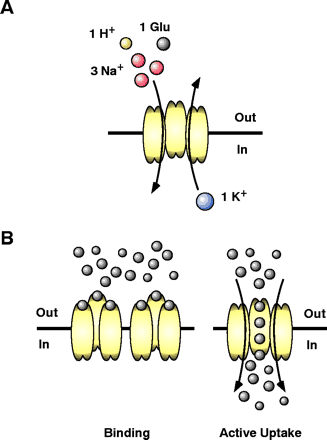
- Institution: Stanford Univ Med Ctr Lane Med Lib/Periodical Dept/Rm L109
- Sign In as Member / Individual
Protein KINASE C–Dependent Remodeling of Glutamate Transporter Function

Transport through glutamate transporters. (A) Glutamate transporters use the Na+, H+, and K+ electrochemical gradients to drive the intracellular accumulation of glutamate into neurons and glial cells. Glutamate uptake is an electrogenic process that requires the inward movement of three Na+, one H+, and one molecule of glutamate coupled with the counter transport of one K+. (B) Glutamate transporters may reduce the amount of synaptic glutamate by two distinct mechanisms. The first mechanism involves glutamate binding that effectively buffers the amount glutamate available for receptor activation. Although this mechanism can be extremely fast, there needs to be a high density of transporters near glutamate release sites on astrocytes or neurons for this mechanism to be effective. The second mechanism involves active uptake. The cycle time for these transporters is estimated to be between 20 and 100 msec; therefore this process is slow compared to some of the very fast excitatory signals that can be a few msec in duration. However, under periods of sustained release or when the receptor signaling is relatively slow, active uptake can shape excitatory activity.


